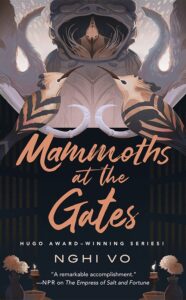In the first two novellas of Nghi Vo’s Singing Hills series — The Empress of Salt and Fortune, and When the Tiger Came Down from the Mountain — violent conflict is kept at a distance, and much of the tension in the stories arises from the question of whether it can continue to be kept from erupting. In the first, the violence is in the past, in the stories that the old woman from Scarlet Lake tells, but the things that she reveals mean that the situation is much more dangerous than it first appeared. In the second, the titular tiger and her sisters would very much like to eat Cleric Chih, and the question is whether they can be held off, not by main force, but by wit and the power of stories. (I haven’t read the third, Into the Riverlands.)
And so it proves in Mammoths at the Gates. Cleric Chih returns from their wanderings to find the abbey at Singing Hills much changed. For starters, it’s nearly empty. Chih soon learns that royal engineers drained a nearby lake, leaving a town uncovered for the first time in about three hundred years (p. 26), so the abbey’s clerics have gone to learn as much as they can before the engineers decide to refill the lake. Cleric Thien, a venerable and much respected teacher to Chih and many others in the abbey, died about three weeks before Chih’s return but has not yet been interred. Ru, one of Chih’s oldest friends, has been made acting Divine, in charge of the abbey while the more senior clerics are away at the lake site.
Then there are the mammoths at the abbey’s gates. Chih learns that before coming to the abbey, Thien had been a powerful lawyer with extensive family connections. Two of Thien’s younger relations are serving in the imperial mammoth corps and have come to Singing Hills to retrieve Thien’s body for internment in the family tombs. They brought along their mammoths to make clear the seriousness of their intent. Ru, as acting Divine, has taken the position that when Thien left their former life to join the abbey, they left it completely, and they will be interred with other clerics of the abbey, as tradition requires. The two sides are at an impasse, and so far the encounter has remained peaceful. Chih would like to keep it that way, but neither side is showing any sign of budging, and time is running out.
To make matters worse, there is an uproar among the abbey’s neixin, the magical birds that can not only talk but also remember all that they experience, and can access their ancestors’ memories. Myriad Virtues accompanied Cleric Thien for much of their time at the abbey, and is in such deep mourning that the whole aviary is unsettled. The birds are as important to the work of the abbey as the humans, and a lasting disturbance among them would be most unwelcome.
Will the headstrong and the stubborn hold so fast to their positions that the mammoths test their strength against the abbey’s stone? Is there a compromise that is not a loss? Are roles defined by tradition and honor so strong that everyone must lose? Mammoths at the Gate is, in part, a look at practical problems of diplomacy. Demands appear irreconcilable; is there a way of looking at the problem that squares the circle? Is there enough good faith to attempt a solution, or is one side more invested in causing conflict than in solving problems? Mammoths at the Gate is also an examination of how people — whether with feathers and wings or with legs and hair — behave under the burden of grief.
The Singing Hills novellas are quiet, but they still have plenty to say.
+++
Doreen did not like this book as much as I did, though she did like the ending very much. This is the fifth bit of Hugo-related writing that I have done this year.

